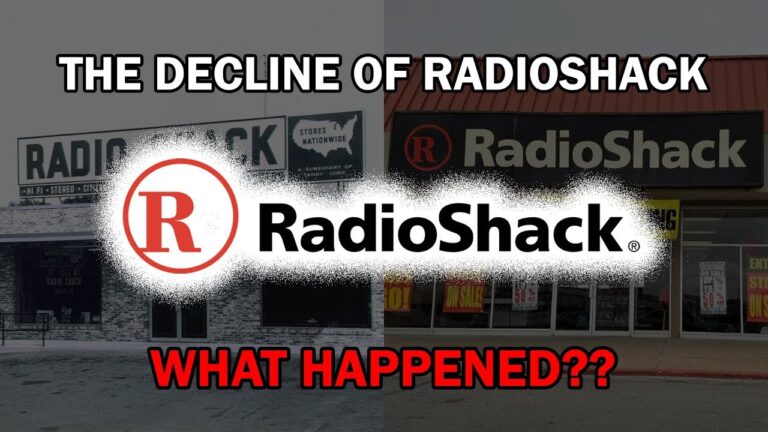Learn about RadioShack and What Happened to it in this Article and Video Guide that talks about Rise and Fall of RadioShack
Based on Public Facts about RadioShack
RadioShack, formerly RadioShack Corporation, is an American retailer founded in 1921. At its peak in 1999, RadioShack operated over 8,000 worldwide stores named RadioShack or Tandy Electronics in the United States, Mexico, United Kingdom, Australia, and Canada. Outside of those territories, the company licensed other companies to use the RadioShack brand name in parts of Asia, North Africa, Latin America, and the Caribbean.
How RadioShack was Started in 1921
The company was started as Radio Shack in 1921 by two brothers, Theodore and Milton Deutschmann, who wanted to provide equipment for the nascent field of amateur radio (also known as ham radio). The brothers opened a one-store retail and mail-order operation in the heart of downtown Boston at 46 Brattle Street. They chose the name “Radio Shack”, which was the term for a small, wooden structure that housed a ship’s radio equipment. The Deutschmanns thought the name was appropriate for a store that would supply the needs of radio officers aboard ships, as well as hams (amateur radio operators).
How was the Name RadioShack Chosen ?
The idea for the name came from an employee, Bill Halligan, who went on to form the Hallicrafters company. The term was already in use — and is to this day — by hams when referring to the location of their stations.The company issued its first catalog in 1939 as it entered the high fidelity music market. In 1954, Radio Shack began selling its own private-label products under the brand name Realist, changing the brand name to Realistic after being sued by Stereo Realist.
During the period the chain was based in Boston, it was commonly referred to by its customers as “Nagasaki Hardware”, disparagingly, as much of the merchandise was sourced from Japan, then perceived as a source of low-quality, inexpensive parts. After expanding to nine stores plus an extensive mail-order business, the company fell on hard times in the 1960s. Radio Shack was essentially bankrupt, but Charles D. Tandy saw the potential of Radio Shack and retail consumer electronics, purchasing the company in 1962 for US$300,000.
RadioShack Files for Bankruptcy
In February 2015, RadioShack Corporation filed for Chapter 11 protection under United States bankruptcy law after 11 consecutive quarterly losses following many Financial and operational Problems.
The Major Reasons for its Failure were :
- 1. They Failed to Digital Transform and did not Catch up on the Internet and E-commerce Bandwagon when the whole world was Beginning to Sell Goods and Products Online – They were left behind in that Race as they did not Anticipate the Change or Adapt to the New Technology Landscape which was beginning to Capitalise upon the Power of Internet and E-Commerce.
- 2. Issues of Product Assortment, Inventory Stock-outs, Limited Store Space and Pricing Strategy in Comparison to their Competitors Amazon and eBay – They suffered from Lack of Inventory (which rose due to Limited Store Space) and had Overpriced Electronics Products – Unappealing Product Assortment that nobody was keen to buy and consumers started to buy Electronics and Computer Products from Other Online Retailers such as Amazon and eBay that had better Inventory and also Great offers.
- 3. High Number of Stores close to each other that Cannibalised Revenues which resulted in a Drop in Profitability and Inventory Issues as less and less people frequented it. It became a high Overhead to maintain so many stores with insufficient inventory in one particular area. So RadioShack had to to close a lot of Stores with such issues.
- 4. Failure to Capitalise on PC Revolution of 1980s & 90s & Shift to Cell Phone Business – RadioShack lost the opportunity to capitalise on the computer revolution of 1980s and 1990s which were latched on to by its Competitors. As such The hardware business of computer sales became less than 10% of Overall Sales, due to lack of Strategic Importance in the Company and it stopped the PC or Hardware Business in 1993. Post that Missed Opportunity, RadioShack latched on to the Cell phones business but it lacked Operational Strategy to address the Critical Issue of Time Taken per Customer to Signup. Also they charged a high Commissions. Many Mobile carriers gradually reduced their business with RadioShack to Reduce the High and Increasing Costs of Customer Acquisition. This Caused RadioShack’s Revenue from mobile phones to drop Significantly. Also lack of Customer Friendly Strategies affected their Customer Engagement and Retention and Customers Started going directly to the Carrier Websites or their Competitors where the Phones were cheaper.
- 5. The Brand Equity took a significant hit due to all round spiralling of Operational, Strategic Issues and Customer lost the Trust of the Brand. RadioShack cultivated a Culture that did not treat Customer as the King and their Arrogance was one of the big reasons for loss of Customer Confidence. Some Customers started Mocking at the Value and Product Radio Shack had to Offer. Terrible Corporate Culture at RadioShack which was based on Relative Performance instead of Absolute Performance with hiring and firing mentality also affected their Overall Image and Morale of the Employees that also resulted in the lower performance of the working staff.


